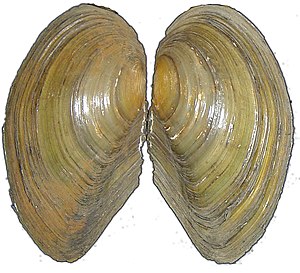Common pond clam
| Common pond clam | ||||||||||||
|---|---|---|---|---|---|---|---|---|---|---|---|---|

Common pond clam ( Anodonta anatina ) |
||||||||||||
| Systematics | ||||||||||||
|
||||||||||||
| Scientific name | ||||||||||||
| Anodonta anatina | ||||||||||||
| ( Linnaeus , 1758) |
The common pond mussel ( Anodonta anatina ) belongs to the family of river and pond mussels (Unionidae). It occurs in almost all of Europe and parts of Western Asia in flowing and still waters on muddy or sandy soils. It is endangered by increasing water pollution and is therefore, like all other species of the Unionida order, under nature protection.
features
The skin is broad to ovoid, thin-rimmed, yellowish to dark brown. The common pond clam grows to about 8-10 cm long. It has no lock teeth, hence its scientific name Anodonta , the "edentulous". The inside of the shell only has a matt pearlescent color, which distinguishes it from the very pearlescent inside of the shell of the great pond clam Anodonta cygnea . Further distinguishing features of the two types of anodonta are the triangular shield, which is more pronounced in anodonta anatina, and the shorter but wider buckle strap.
Way of life
The pond mussel is a bottom animal and anchors itself with its foot in the soft or sandy soil. She can also move slowly with the help of her foot. It stirs up the ground and sucks up the swirled up sediment to filter out food. The food consists of detritus and plankton , but primarily of soil-living organisms such as small algae ( Vaucheria , Ulothrix , diatoms ), cyanobacteria ( Oscillatoria ) and other microorganisms. As a filter feeder, it cleans the water and is an important factor in the water ecosystem . Anodonta anatina can filter around 40 liters of water per day .
The common pond mussel used to be very common, as its German-language species name “common” in the sense of “general”, “common” indicates. Large quantities of the mussel were removed from the bank substrate when the stream was straightened. In the vicinity of villages it used to be used as fodder for ducks or pigs .
Reproduction and development
The species in the river mussel family have developed a specialization that other freshwater mussels do not show. Their development cycle depends on an intermediate stage in a host fish, where the larvae parasitize on the skin or on the gills.
The common pond clams are predominantly separate sexes. After fertilization in late summer, the eggs overwinter in the mussel's gill space and grow into double -lobed glochidium larvae. These glochidia are released in the spring when a host fish is nearby. The expulsion of the 0.2 mm glochidia is probably triggered by a chemical stimulus. For the duck mussel different types of fish as hosts in question, including the perch ( Perca fluviatilis ), silver bream ( Blicca bjoerkna ), Norway ( Osmerus eperlanus ), tench ( Tinca tinca ), roach ( Rutilus rutilus ) and gudgeon ( Gobio gobio ) and Sticklebacks (Gasterosteidae). The glochidia can attach themselves to the entire body of the host fish, preferably to the fins. After a few weeks of development, the glochidia fall off the host fish and hide in the sand gap system of the water bed, where they are protected from predators. They become sexually mature after around 2 to 5 years and can live up to 15 years, or older if the conditions are good.
Danger
Because of the large number of host fish on which the glochidial larvae of the common pond mussel can develop, it is less endangered. Nevertheless, the complicated development cycle represents a disadvantage compared to the migrating mussel ( Dreissena polymorpha ), which is distributed as a neozoon over the river systems , whose larval stages can spread over the free water. The migrating mussel was carried off to the pond mussels' distribution areas and overgrown their locations in large numbers and even the pond mussels themselves.
literature
- Rosina Fechter and Gerhard Falkner: molluscs. 287 pp., Mosaik-Verlag, Munich 1990 (Steinbach's Nature Guide 10), ISBN 3-570-03414-3
- C. Wesenberg-Lund: biology of freshwater animals. Invertebrates. Julius Springer, Vienna, 1939
- Michael L. Zettler et al .: The land and freshwater mollusks of Mecklenburg-Western Pomerania. 318 p., Obotritdruck, Schwerin 2006 ISBN 3-933781-52-3
Web links
- Large clams
- Anodonta anatina inthe IUCN 2013 Red List of Threatened Species . Posted by: Van Damme, D., 2011. Retrieved February 13, 2014.
Individual evidence
- ↑ For a list of the fish species that are suitable for the common pond mussel, see: Jürgen Geist, Christine Schmidt: Stocking measures with mussels. In: Bayerns Fischerei + Gewässer 3/2004, Weihenstephan, 2004.
